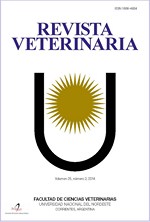Epidemiology of canine transmissible venereal tumor in Reynosa Tamaulipas Mexico
DOI:
https://doi.org/10.30972/vet.3416603Keywords:
Tumor, canine, risk factors, epidemiologyAbstract
The CTVT is transmitted mainly through sexual contact, with females being the most exposed to the pathology; vincristine sulfate is currently the most effective therapy. In the present work, 28 canines were analyzed, mostly of indefinite breed. A diagnosis was made by complete physical examination and surveys were carried out on their owners to determine risk factors. The proportion of the disease was similar in females and males under 5 years of age, but considerably higher in adult males than in females; only 25% of those older than 5 years were female. The incidence of this tumor in non-sterilized animals was 28% higher than in sterilized ones. The presence of the tumor was considerably higher in non-rescued males compared to females in the same condition (73 and 27%). Finally, 89% of the reported cases presented lesions in the genital region. The objective of this work was to identify factors associated with the persistence of CTVT in the city of Reynosa Tamaulipas.
Downloads
Downloads
Published
How to Cite
Issue
Section
License
Revista Veterinaria (Rev. Vet.) maintains a commitment to the policies of Open Access to scientific information, as it considers that both scientific publications as well as research investigations funded by public resources should circulate freely without restrictions. Revista Veterinaria (Rev. Vet.) ratifies the Open Access model in which scientific publications are made freely available at no cost online.











.jpg)
.jpg)



